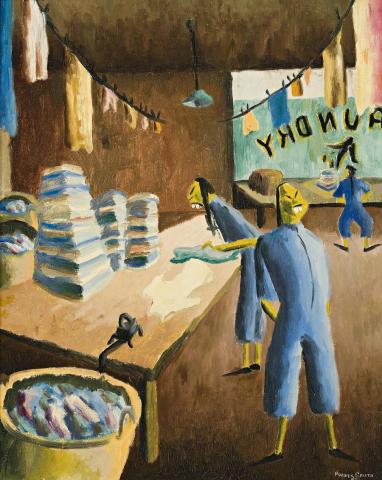CHINESE LAUNDRY, 1937
Peter Purves Smith
oil on canvas
50.5 x 40.5 cm
signed and dated lower right: PURVES SMITH / 1937
The artist's widow Maisie, later Lady Drysdale, New South Wales
Joseph Brown Gallery, Melbourne 1979
Private collection, Melbourne
Sotheby’s, Melbourne, 20 August 1996, lot 165, The Hicks Family Collection, Melbourne
Autumn Exhibition 1979, Joseph Brown Gallery, Melbourne, 5 - 20 April 1979, cat. 89, (illus.)
The year 1937, when Chinese Laundry was painted, was an important one for Peter Purves Smith, both artistically and personally. In May here turned to Melbourne and enrolled soon after in George Bell's school in Bourke Street. Here he developed a close friendship with Russell Drysdale and fell in love with his future wife Maisie Newbold. For his art it was an experimental time, his paintings ranging from Surrealist, as in Ricketts Point, c.1937, in the Art Gallery of South Australia, to Nude, 1937, in the Heide Museum of Modern Art, inspired by Matisse with a dash of Modigliani, striking in its originality and free depiction of the female figure. Years later fellow student, Maie Casey reflected, ‘In Bell's studio in the 1930s Peter Purves Smith emerged as an artist who was completely himself, with a certainty and direction not always found amongst young students. Everything he drew or painted bore his own stamp, for originality and wit, for command of colour and line.’1 This is readily apparent in such different works as Burke and Wills, 1937, Topee: On the Honeymoon, 1937, in the National Gallery of Australia, Canberra, and Chinese Laundry.
There was also the influence of his teacher, George Bell. In a 1937 lecture, Bell had traced distortion in art back to its very beginnings, found it in Michelangelo and throughout the Venus de Milo. ‘If it were not,’ he said, ‘it would not be a work of art. It is the intelligence of the distortion that makes the work of art.’2 In Chinese Laundry Smith portrays the Chinese workers with satire and wit through the use of distortion, particularly in the angularity of the figures. Uniformly dressed to emphasis servitude in their menial tasks, and of like appearance in the over-emphasis of their foreign slit eyes and protruding teeth, he images a sweatshop of manual labour. He adds an idiosyncratic, irreverent touch in the hand iron on its stand to the left, metamorphosed into a Chinese dragon. He was given to such whimsy in his art. Purves Smith died tragically young at the age of thirty-seven. A few years later, his teacher and fellow artist, George Bell, wrote: ‘His range is so wide, his approach so varied, it is impossible to forecast what he would have achieved had he lived. One thing, however, is certain - he was and would have remained unique in Australian art.’3
1. Casey, M., quoted in Homage to Peter Purves Smith, Joseph Brown Gallery, Melbourne, 1976, no pagination
2. Bell, G., quoted in Moore, F. St. J., Classical Modernism: The George Bell Circle , National Gallery of Victoria, Melbourne, 1992, p. 35
3. Bell, G., The Sun, April 1950, quoted in Homage to Peter Purves Smith, op. cit.
DAVID THOMAS
